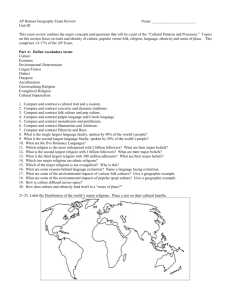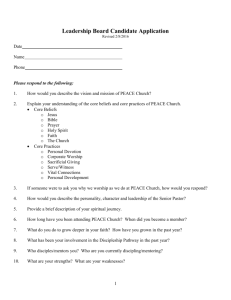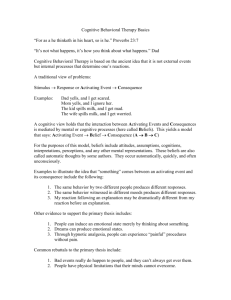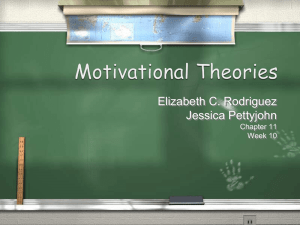Outline October 2009
advertisement
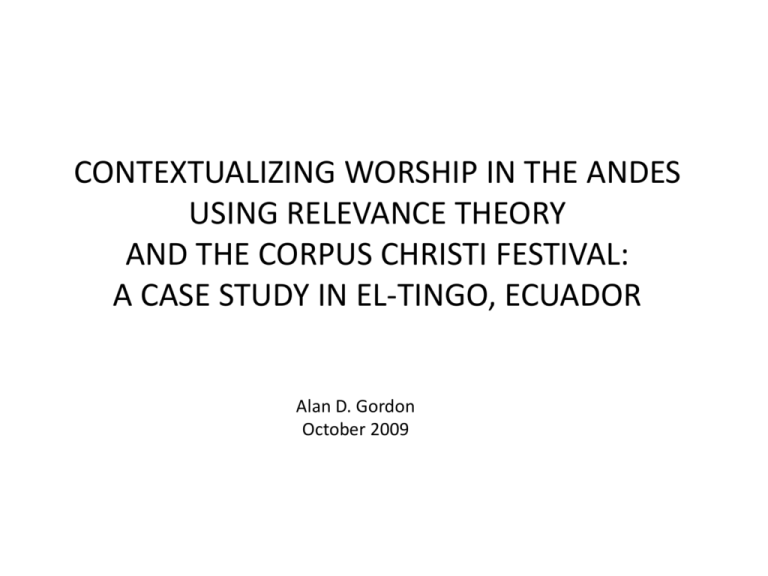
CONTEXTUALIZING WORSHIP IN THE ANDES USING RELEVANCE THEORY AND THE CORPUS CHRISTI FESTIVAL: A CASE STUDY IN EL-TINGO, ECUADOR Alan D. Gordon October 2009 PART I – INTRODUCTION AND REVIEW OF LITERATURE Chapter 1 - Introduction: Evangelical worship the rural Andes of Ecuador Chapter 1 – Contextualization theory: which paradigm? Chapter 2 - Communication theory: cognitive environment Chapter 3 - Ethnomusicological theory: the music ritual Chapter 4 - Epistemology: phenomenology in academic research Summary: Contextualization of worship must take place at the deep level, by understanding the Indian's cognitive environment. Music ritual is one method to discover cognitive environment. Phenomenology will be the epistemology. CONTEXTUALIZING MUSIC-WORSHIP Traditional route Change the form of our music ritual to theirs Evangelical worship Indigenous festivals Proposed route Adopt their cognitive environment Leave our cognitive environment Change our understanding to that of their music ritual MUSIC-WORSHIP COMMUNICATES Evangelical worship Evangelical worship Evangelical worship Is not understood by the indigenous folk Must change Is now understood by the indigenous folk ? Indigenous folk Evangelical worship Indigenous folk Chapter 2 The Principle Theory for the Dissertation: (Relevance Theory) Cognitive Environment Cognitive Environment Context Context Intent Evidence Meaning Context Context Context Context COMMUNICATOR RECEIVER Cross-cultural communication: the communicator must adapt/convert to a new context in order to communicate effectively. Chapter 3 The Secondary Theory for the Dissertation: (Ethnomusicological Theory) 1 Music-Ritual 2 Beliefs Extract Ethnomusicological theory: music ritual is one way to discover deep-level beliefs. Chapter 5 - Methodology: The structure of the research THE THEORY Cross-cultural communication: the communicator must adapt/convert to a new context in order to communicate effectively. THE MISSIOLOGICAL IMPLICATIONS OF THE THEORY In order to adapt/convert, the communicator must FIRST understand: BOTH the receptor’s cognitive environment AND his/her own cognitive environment. But just how does one go about doing this? MY PROPOSAL To discover cognitive environments through music-ritual (EM theory). EM theory proposes that deep-level beliefs produce the music-ritual. I propose using the reverse process. Assume: “cognitive environment” = “deep-level beliefs” The following is a diagram of my research: (My dissertation has only reached step #3.) Chapter 5 1 3 Music-Ritual Music-Ritual 2 Beliefs New forms Extract Beliefs 4 Beliefs Beliefs 5 New forms Evangelicals 1. 2. 3. 4. 5. Rural folk Use music-ritual to discover one’s own beliefs. Extract these from one’s cultural context. Participate with rural folk in their music-ritual to discover, with them, their beliefs. Dialogue with them about their beliefs and one’s own. Create new forms of music-ritual. Chapter 6 – Data Collection and Analysis Context 1. Compare evangelical and 2006 1. The two are very different! indigenous music-rituals. S 2007 2. Their mentality is concrete, R 2. Focus on one indigenous festival. T communal, and identity based. E 2008 R S 3. Personal reflection as a 3. My mentality is abstract, A U 20-year veteran missionary. individual, and proposition based. T L E T G Y Analysis Conclusion: a North-American missionary may need to change from an abstract, individualistic, proposition-based mentality to a concrete, communal, identity-based mentality in order to effectively communicate the gospel in the rural Andes of Ecuador. (The Evangelical Church in Ecuador may need to do the same!)
